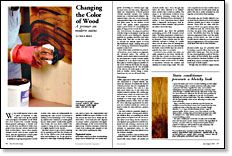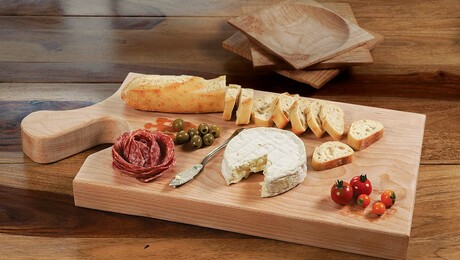
Synopsis: The appearance of plain woods can be enhanced by staining. Few can afford to build every project from first-rate cabinet hardwoods. Most woodworkers, Chris A. Minick knows, enhance cheaper woods with stain. To get good results for a wide range of staining situations, you need to know the characteristics and qualities of different types of stains. He explains these and discusses proper surface preparation and application techniques. He discusses pigmented stains, dye stains, and chemical stains, and then talks about mixing them together and layering them. Side information offers details on prep and application, along with using conditioner.
Why would anyone want to stain a piece of furniture or cabinetry and cover up the natural color and figure of beautiful wood? While few of us would even consider staining flame-grained mahogany or burled walnut, not all of us can afford to build every project from first-rate cabinet hardwoods. Most woodworkers I know often employ cheaper woods, such as pine, poplar and birch. And the appearance of such plain woods can be enhanced by staining.
In addition to giving inexpensive woods a richer color, stains are indispensable for matching the color of new woodwork to existing wood furnishings or for evening up natural color variations in boards glued up into wider panels. A judiciously applied coat of stain can even lend a subtle color contrast to bring out the spectacular grain of a highly figured exotic species.
But don’t expect to get a perfect staining job by picking up the first can of stain you see on the shelf at your local hardware store and sloshing it on. To get good results for a wide range of staining situations, you need to know the characteristics and qualities of different types of stains, so you can choose the best one to obtain the desired effect. Good stain jobs also depend on proper surface preparation and application technique, so the wood receives the stain evenly. A further assurance of success comes from making stain samples to test the color before applying the stain.
Pigmented stains
Most stains used in modern woodworking shops can be divided into two broad categories according to colorant type: pigrnented stains and dye stains. Pigmented stains are suspensions of finely ground colored minerals (mostly iron oxides) mixed into a solvent-based solution”. Pigmented stains color the wood when pigment granules lodge in the natural crevices and grain pores on the surface of the wood. This quality makes pigmented stains a good choice for accentuating the grain of ring-porous woods like oak and ash. Unfortunately, the pigment particles will also lodge in sandpaper scratches and boldly reveal a poor sanding job. Pigment particles are opaque; therefore, they resist fading well. They also act like thin paint to obscure the delicate figure of wood like fiddleback maple, making them good for covering up unattractive inexpensive species or plywood.
From Fine Woodworking #101
For the full article, download the PDF below:
Fine Woodworking Recommended Products

Odie's Oil

Waterlox Original

Foam Brushes





















Log in or create an account to post a comment.
Sign up Log in